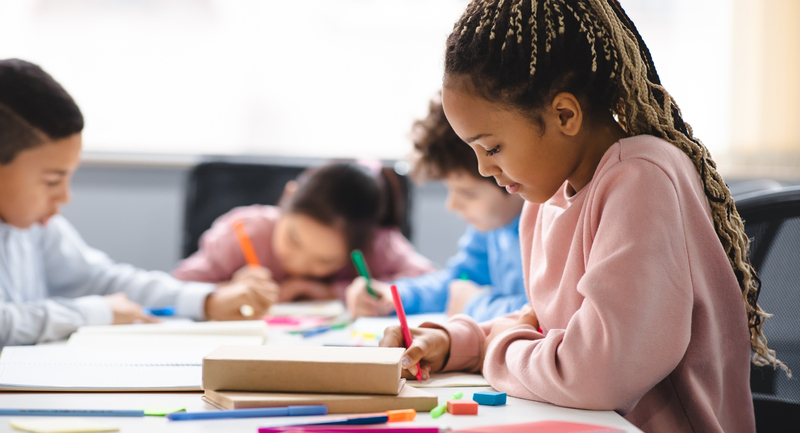The state of special education isn’t what it used to be –– and that’s a good thing. In years past, students with special needs were often segregated from those in general education classrooms and didn’t receive the benefits that inclusive classrooms offer. Fortunately, integration is more the norm in schools today, and educators are learning to work together to meet the needs of every student in their care.
Two Types of Classrooms
Historically, students with disabilities were often denied access to public schools, placed in segregated classrooms or placed in regular classrooms without the right support. However, the Individuals with Disabilities Education Act (IDEA) changed all that. The IDEA “makes available a free appropriate public education to eligible children with disabilities throughout the nation and ensures special education and related services to those children.” It also requires that these students receive that education alongside children who are not disabled, as much as that is possible. Fortunately, that’s increasingly the case within schools today.
According to “Special Education by the Numbers: A Look into Today’s Schools,” from 1989-2010, there was a 90 percent increase in the time special education students spent in general education classrooms. The students surveyed had a variety of disability types that adversely affected their educational performance:
- specific learning disability, 35 percent;
- speech/language impairment: 21 percent ;
- other health impairment: 12 percent;
- autism spectrum disorder: 8 percent;
- intellectual disability: 7 percent ;
- developmental delay: 6 percent;
- emotional disturbance: 6 percent;
- multiple disabilities: 2 percent;
- hearing impairment: 1 percent;
- orthopedic impairment: 1 percent.
Corinne Hyde, an associate teaching professor of clinical education at USC Rossier’s Master of Arts in Teaching program, stresses the need for teacher preparation to appropriately support students with such disabilities: “In the modern classroom, students with special needs are very frequently included in classrooms with students who do not have special needs. Thus, teachers must be prepared to celebrate, challenge and support students with varying needs in an inclusive classroom.”
Benefits of Integration
There are many benefits to inclusive classrooms, and they extend to students with and without disabilities. In an article for The Atlantic, middle school principal Alla Vayda-Manzo says high expectations and instructional strategies are good for students with special needs, helping them be “more successful than they would be had they been in a separate, self-contained environment.” The publication cites research that shows “as many as 85 percent of students with disabilities can master general education content if they receive educational supports,” and notes benefits that include:
- more instructional time;
- fewer absences;
- better post-secondary outcomes;
- social benefits to non-disabled students as they learn to form “positive relationships” and better relate to “a variety of people.”
Additional benefits include:
- differentiated instruction geared to each student’s unique learning style;
- supportive teaching strategies with “specially designed instruction and support”;
- reduced stigma, since everyone is viewed as a having unique learning needs;
- effective use of resources, since in-classroom specialists can help all students;
- high expectations for all, since the goals for all students, should be based on state academic standards.
Strategies for Inclusion
Teachers who are working in integrated classrooms face unique challenges, especially if they haven’t received formal training to work with students with special needs. Fortunately, there are resources that provide effective strategies, such as those recommended by Special Education Guide:
- Begin at the end, making use of backward planning to ensure daily lesson planning aligns with year-end goals.
- Embrace universal design to make the curriculum accessible to all students, regardless of their unique needs.
- Apply multiple intelligence theory, which will aid in accessing the unique pathways by which each student processes information.
- Incorporate life skills training by using routine classroom tasks to create learning opportunities for special education students.
- Employ collaborative teaching techniques by partnering with special education teachers and others.
- Formulate a flexible behavior management plan by maintaining control of the classroom in a manner that adapts to the needs of special education students.
ASCD emphasizes the need for collaboration and highlights the importance of:
- positive attitudes and beliefs toward special education students;
- a commitment to provide what’s needed to meet their needs;
- school leadership support in terms of adequate personnel, training, equipment and policies; and
- instructional methods that are adapted to the needs of special education students and foster a learning environment that is cooperative and promotes socialization.
If you are a parent with a special-needs child, you can help your child get ready to join an integrated classroom by understanding the teaching model that will be used. For example, if a co-teaching model is in place, you can explain there will be two teachers in the class all day. If a “push in” model is used, a special education teacher will come in at specific times to offer support. Either way, it’s important for your child to understand the teachers are there to help all students, and that having special needs isn’t about stigma — it’s about learning in a way that supports the individuality of everyone in the class.







